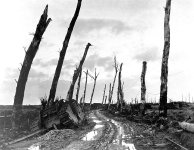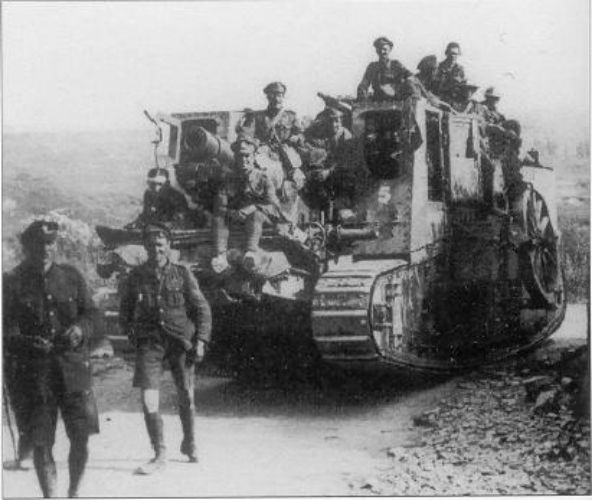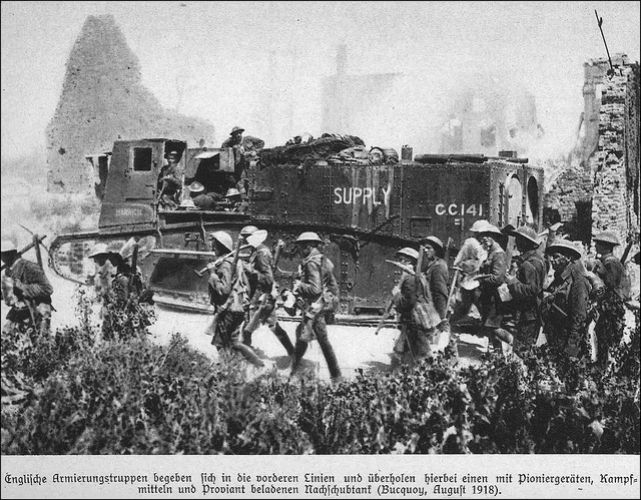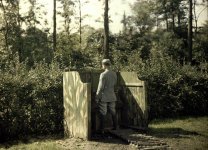Thanks for posting it, Rob. I can't remember having seen it before. ^&cool -- AlGlad you like it Al, I thought it a good pic and somehow unusual.
Rob
You are using an out of date browser. It may not display this or other websites correctly.
You should upgrade or use an alternative browser.
You should upgrade or use an alternative browser.
WW1 Pic Of the Day (1 Viewer)
- Thread starter Rob
- Start date
Thanks, Rob. That's another crisp picture I haven't seen. Once again, with all the personel around the aircraft, I am impressed by just how small these WW1 fighters were. ^&cool -- AlHere's another Camel Al in another unusual shot
Adjusting the compass of a Sopwith Camel on a revolving table; Rang du Fliers Aerodrome, 12th July 1918.

© IWM (Q 12084)
Rob
Four Star General
- Joined
- May 18, 2005
- Messages
- 26,622
Thanks, Rob. That's another crisp picture I haven't seen. Once again, with all the personel around the aircraft, I am impressed by just how small these WW1 fighters were. ^&cool -- Al
My pleasure Al, they do appear small don't they, the Camel sometimes has a small chubby kind of look about it I think. (it wasn't really of course but pics sometimes make it look that way)
Rob
Neat picture. I have one of what I believe is the same aircraft crash taken from a different angle. It is identified to a Lt. Bush of 45 Squadron. The crash was caused by engine failure. The white dumbbell became the official squadron marking on August 26, 1917. The aircraft number 5 was in white and might have been 'B' flight at this time as 'A' and 'C' flights used letters, although 'B' flight later moved to letters, as well. -- AlBattles of Ypres 1917. A Sopwith 'Camel' with its nose buried in the ground after being forced down. At Clapham Junction, in front of Zillebeke, 26th September 1917.

© IWM (Q 7784)
waynepoo
Colonel
- Joined
- Jan 3, 2012
- Messages
- 9,729
Victoria Cross laureate of the first A.I.F
Corp. George Julian ''Snowy'' Howell. VC,MM. 1st. Battalion.
In preparation for an attack on the Hindenburg Line at Bullecourt, the
1st Infantry Brigade-of which the 1st Battalion was part-was attached to the 2nd
Division, Australian Corps. The attack commenced in the morning of 3 May 1917,
with the 2nd Division lined up in conjunctionwith thirteen other divisions. Despite
some progress made early in the attack, the Australian forces were soon held up by
strong opposition, and in the evening the 1st Battalion was entrenched in the old German
line know as 'OG1'. Three of the battalion's companies occupied the line, while a fourth
was placed in reserve. Their position was such that they occupied a wedge into the German
line, while two flanks were in German held territory.
From the initial attack, only the Canadians on the extreme right and the 3rd Australian
Brigade on the extreme left were able to capture and hold their set objectives. Over the
course of the next three days, severe fighting took place and further troops were drawn in
to hold and extend the gains of 3 May. On 6 May, the Germans launched a counter-attack
which forced the 3rd Brigade to withdraw from their trenches; it was during this
engagement that Howell was to preform the act which was to earn him the Victoria Cross.
At 06:00, Howell, who was in charge of a post to the right of the line,
noticed the battalion on the right flank was being forced out of it's trench
and was beginning to retire. Immediately alerting battalion HQ, Cpt.A. McKenzie-
who had assumed temporary command of the battalion- hurriedly organised
a group of non-combatant soldiers from HQ together with several signallers to form
a defensive line along a road bank in order to fend off the expected German advance.
A fierce bombing and grenade fight soon ensued, with both sides suffering heavy casualties,
Fearing the Germans would outflank his battalion, Howell climbed onto the top of the
parapet and began running along the trench line throwing bombs down on the Germans,
all the while being subject to heavy rifle and bomb fire, Howell was supported by Lt. T.Richards
who followed him along the trench firing bursts from his lewis gun. Soon exhausting his supply
of bombs, Howell began to attack with his bayonet until he fell into the trench wounded.
Howell had been hit in both legs by MG fire, and when he was brought into the clearing station
some hours later, it was discovered he had suffered at least twenty-eight separate wounds, Due to his
actions, the ground which had been lost was soon retaken, and the Germans attack was
later repulsed.
Wayne.

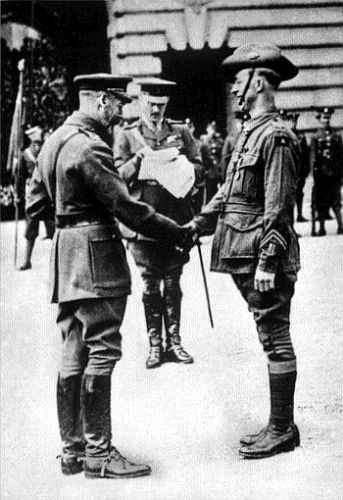
Corp. George Julian ''Snowy'' Howell. VC,MM. 1st. Battalion.
In preparation for an attack on the Hindenburg Line at Bullecourt, the
1st Infantry Brigade-of which the 1st Battalion was part-was attached to the 2nd
Division, Australian Corps. The attack commenced in the morning of 3 May 1917,
with the 2nd Division lined up in conjunctionwith thirteen other divisions. Despite
some progress made early in the attack, the Australian forces were soon held up by
strong opposition, and in the evening the 1st Battalion was entrenched in the old German
line know as 'OG1'. Three of the battalion's companies occupied the line, while a fourth
was placed in reserve. Their position was such that they occupied a wedge into the German
line, while two flanks were in German held territory.
From the initial attack, only the Canadians on the extreme right and the 3rd Australian
Brigade on the extreme left were able to capture and hold their set objectives. Over the
course of the next three days, severe fighting took place and further troops were drawn in
to hold and extend the gains of 3 May. On 6 May, the Germans launched a counter-attack
which forced the 3rd Brigade to withdraw from their trenches; it was during this
engagement that Howell was to preform the act which was to earn him the Victoria Cross.
At 06:00, Howell, who was in charge of a post to the right of the line,
noticed the battalion on the right flank was being forced out of it's trench
and was beginning to retire. Immediately alerting battalion HQ, Cpt.A. McKenzie-
who had assumed temporary command of the battalion- hurriedly organised
a group of non-combatant soldiers from HQ together with several signallers to form
a defensive line along a road bank in order to fend off the expected German advance.
A fierce bombing and grenade fight soon ensued, with both sides suffering heavy casualties,
Fearing the Germans would outflank his battalion, Howell climbed onto the top of the
parapet and began running along the trench line throwing bombs down on the Germans,
all the while being subject to heavy rifle and bomb fire, Howell was supported by Lt. T.Richards
who followed him along the trench firing bursts from his lewis gun. Soon exhausting his supply
of bombs, Howell began to attack with his bayonet until he fell into the trench wounded.
Howell had been hit in both legs by MG fire, and when he was brought into the clearing station
some hours later, it was discovered he had suffered at least twenty-eight separate wounds, Due to his
actions, the ground which had been lost was soon retaken, and the Germans attack was
later repulsed.
Wayne.


waynepoo
Colonel
- Joined
- Jan 3, 2012
- Messages
- 9,729
Victoria Cross laureate of the first A.I.F
Lt. George Morby Ingram. VC, MM. 24th. Battalion.
For most conspicuous bravery and initiative during the attack on Montbrehain,
East of Peronne, France, on 5th October, 1918. When early in the advance his platoon
was held up by a strong point, Lt. Ingram, without hesitation, dashed out and rushed
the post at the head of his men, capturing nine machine-guns and killing 42 enemy
after stubborn resistance. Later, when the company had suffered severe casualties
from enemy posts, and many leaders had fallen, he at once took control of the situation,
rallied his men under intense fire, and led them forward. He himself rushed the first
post, shot six of the enemy, and captured a machine-gun, thus overcoming serious
resistance.
On two subsequent occasions he again displayed dash and resource in the capture of enemy
posts, inflicting may casualties and taking 62 prisoners. Throughout the whole day he showed
the most inspiring example of courage and leadership, and freely exposed himself regardless
of danger.
Wayne.
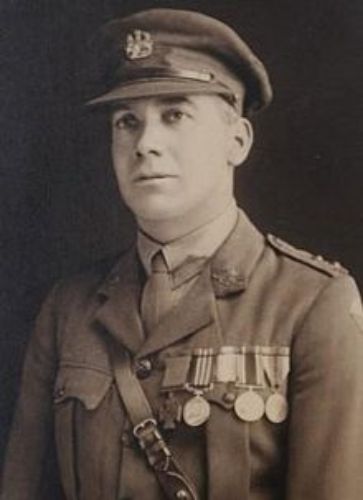
Lt. George Morby Ingram. VC, MM. 24th. Battalion.
For most conspicuous bravery and initiative during the attack on Montbrehain,
East of Peronne, France, on 5th October, 1918. When early in the advance his platoon
was held up by a strong point, Lt. Ingram, without hesitation, dashed out and rushed
the post at the head of his men, capturing nine machine-guns and killing 42 enemy
after stubborn resistance. Later, when the company had suffered severe casualties
from enemy posts, and many leaders had fallen, he at once took control of the situation,
rallied his men under intense fire, and led them forward. He himself rushed the first
post, shot six of the enemy, and captured a machine-gun, thus overcoming serious
resistance.
On two subsequent occasions he again displayed dash and resource in the capture of enemy
posts, inflicting may casualties and taking 62 prisoners. Throughout the whole day he showed
the most inspiring example of courage and leadership, and freely exposed himself regardless
of danger.
Wayne.

A VERY evocative picture of WW1. Complete desolation. I like the name of the tank. -- AlDon't know if I showed this picture already
a street in Poelkapelle with a knocked out tank - 1918. As you can see the village has been erased from the surface of the earth
guy
View attachment 135696
waynepoo
Colonel
- Joined
- Jan 3, 2012
- Messages
- 9,729
Victoria Cross laureate of the first A.I.F
Sgt. Reginald Roy Inwood. VC. 10th Battalion.
Inwood was awarded the Victoria Cross for actions during the period
19-22 September 1917 in an attack at Polygon Wood, near Ypres, Belgium
during the Battle of Menin Road.
''For most conspicuous bravery and devotion to duty during the advance to
the second objective. He moved forward through our barrage alone to an enemy
strong point and captured it, together with nine prisoners, killing several of the
enemy. During the evening he volunteered for a special all night patrol, which
went out 600 yards in front of our line, and there-by his coolness and sound
judgment-obtained and sent back very valuable information as to the enemy's
movements. In the early morning of 21 September, Private Inwood located a
machine-gun which was causing several casualties. He went out alone and bombed
the gun and team, killing all but one, whom he brought in as a prisoner with the gun.''
He later achieved the rank of Sergeant.
Wayne.

Sgt. Reginald Roy Inwood. VC. 10th Battalion.
Inwood was awarded the Victoria Cross for actions during the period
19-22 September 1917 in an attack at Polygon Wood, near Ypres, Belgium
during the Battle of Menin Road.
''For most conspicuous bravery and devotion to duty during the advance to
the second objective. He moved forward through our barrage alone to an enemy
strong point and captured it, together with nine prisoners, killing several of the
enemy. During the evening he volunteered for a special all night patrol, which
went out 600 yards in front of our line, and there-by his coolness and sound
judgment-obtained and sent back very valuable information as to the enemy's
movements. In the early morning of 21 September, Private Inwood located a
machine-gun which was causing several casualties. He went out alone and bombed
the gun and team, killing all but one, whom he brought in as a prisoner with the gun.''
He later achieved the rank of Sergeant.
Wayne.

waynepoo
Colonel
- Joined
- Jan 3, 2012
- Messages
- 9,729
Victoria Cross laureate of the first A.I.F
Cpt. Albert Jacka. VC, MC & Bar. 14th Battalion.
War office, 24th July, 1915.
'His Majesty the KING has been graciously pleased to award the Victoria Cross to
the undermentioned Non-commissioned Officer:-
No.465 Lance-Corporal Albert Jacka, 14th Battalion, Australian Imperial Force.
For most conspicuous bravery on the night of the 19th-29th May, 1915 at ''Courtney's Post'',
Gallipoli Peninsula.
Lance-Corporal Jacka, while holding a portion of our trench with four other men, was heavily
attacked. When all except himself were killed or wounded, the trench was rushed and occupied
by seven Turks. L/Corp Jacka at once most gallantly attacked them single-handed, and killed
the whole party, five by rifle fire and with the bayonet.'
Following his VC action, Jacka instantly became a national hero, he received the 500 pounds
and gold watch that the prominent Melbourne business and sporting identity, John Wren, had
promised to the first Australian of the war to receive the VC. Jacka received rapid promotions,
first to Corporal on 28 August 1915, Sergeant on 21 September 1915 and Company Sergeant
Major on 14 November 1915.
On 29 April 1916 he was commissioned a Second Lieutenant and Captain on 15 March 1917.
Many believe he should have received a Bar to his VC and this remains a controversial subject
to this day.
Wayne.
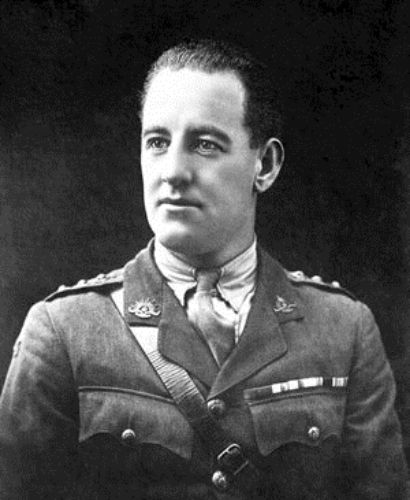
Cpt. Albert Jacka. VC, MC & Bar. 14th Battalion.
War office, 24th July, 1915.
'His Majesty the KING has been graciously pleased to award the Victoria Cross to
the undermentioned Non-commissioned Officer:-
No.465 Lance-Corporal Albert Jacka, 14th Battalion, Australian Imperial Force.
For most conspicuous bravery on the night of the 19th-29th May, 1915 at ''Courtney's Post'',
Gallipoli Peninsula.
Lance-Corporal Jacka, while holding a portion of our trench with four other men, was heavily
attacked. When all except himself were killed or wounded, the trench was rushed and occupied
by seven Turks. L/Corp Jacka at once most gallantly attacked them single-handed, and killed
the whole party, five by rifle fire and with the bayonet.'
Following his VC action, Jacka instantly became a national hero, he received the 500 pounds
and gold watch that the prominent Melbourne business and sporting identity, John Wren, had
promised to the first Australian of the war to receive the VC. Jacka received rapid promotions,
first to Corporal on 28 August 1915, Sergeant on 21 September 1915 and Company Sergeant
Major on 14 November 1915.
On 29 April 1916 he was commissioned a Second Lieutenant and Captain on 15 March 1917.
Many believe he should have received a Bar to his VC and this remains a controversial subject
to this day.
Wayne.

Rob
Four Star General
- Joined
- May 18, 2005
- Messages
- 26,622
British troops in a captured German trench at Serre, March 1917. Serre was occupied by men of the 7th, 9th and 62nd Divisions on 25 February 1917 during the preliminary stages of the German withdrawal to the Hindenburg Line.

© IWM (Q 1787)

© IWM (Q 1787)
Users who are viewing this thread
Total: 2 (members: 0, guests: 2)



